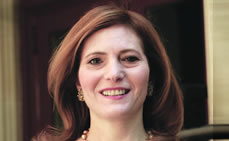DISTINGUISHED LEADER IN EDUCATION 2012
President Jennifer Raab, Hunter College
By Joan Baum, Ph.D.
 “Interdisciplinary learning” and “collaboration” are terms you repeatedly hear when talking to Jennifer Raab about Hunter College’s strategic plan initiatives currently underway and the new facilities being completed that will help to realize those initiatives in dramatic ways. Now in her 11th year as President, Raab sees her position as continuing to get more challenging and more rewarding. “College” hardly describes Hunter’s presence and role in New York City. It seems more like a university, boasting the largest undergraduate and graduate arts and sciences school in the CUNY system, which consists of four freestanding professional schools, and buildings all over Manhattan.
“Interdisciplinary learning” and “collaboration” are terms you repeatedly hear when talking to Jennifer Raab about Hunter College’s strategic plan initiatives currently underway and the new facilities being completed that will help to realize those initiatives in dramatic ways. Now in her 11th year as President, Raab sees her position as continuing to get more challenging and more rewarding. “College” hardly describes Hunter’s presence and role in New York City. It seems more like a university, boasting the largest undergraduate and graduate arts and sciences school in the CUNY system, which consists of four freestanding professional schools, and buildings all over Manhattan.
A new complex in East Harlem, opened in 2011, brings together for the first time the School of Social Work and the School of Public Health and unites them in one of the city’s most underserved neighborhoods. “We broke the silos down,” says President Raab. People in academia tend to get insular and not see or act on the benefits of talking to people in other disciplines. AIDS research, for example, is often viewed either as belonging to science or social science, but in the new East Harlem complex, faculty — and students — will be working beyond “boundaries” and thus more effectively. The president expects that in 15 years it will be apparent that Hunter will have made a difference in East Harlem — that people in the community will be healthier, more socially secure and better educated.
She attributes the changes that will occur in East Harlem to what she terms GIS – geophysical information system. GIS will enable researchers to map data in a way analogous to how GPS works in a car. Scientists and social scientists will be able to integrate census and health data, for example, showing block-by-block concentrations of people with asthma or diabetes, and respond — and educate. Political and civic association leaders in the community are supportive of this initiative, President Raab notes, because of Hunter’s intention to study and stay. “Don’t just come to do research on us and leave,” they said. “The college listened,” and extended itself. As part of the East Harlem complex initiative, Hunter has partnered with P.S. 7 and the “I Have a Dream Foundation” to bring health care into the schools.
Another segment of the strategic plan involves strengthening the bond between Hunter and Weill Cornell Medical College. A $50 million federal grant given to Cornell, called a “translational research grant,” links Hunter College faculty with doctors and with the community — enhancing research and internship opportunities. Other grants given directly to Hunter will bring together doctors and nurses and social workers. Hunter will also be moving onto a floor of a Weill Cornell building at 69th Street and York Avenue. Hunter gets bigger, it gets better, but it’s not all science.
The thriving Roosevelt House’s Public Policy Institute certificate programs, located in the historic space on East 65th Street, continues to host a prestigious group of leaders from government and the private sector.
Hunter is also creating a “21st century arts school” in Tribeca that is arguably among the more dazzling of strategic plan initiatives. Already a highly competitive program, the MFA in Studio Art gets 600 applications for 50 spots and has global outreach. The new building, scheduled to open January 2013, will include a street-level gallery, more performance and exhibition space and will be able to offer teaching artists in all disciplines greater opportunity to train future artists, while the future artists, the students, will be able to afford shows, museums and performances.
Jobs of course are extremely important, but, as the president points out, 80 percent of Hunter students, an overwhelming number of them immigrants, already have jobs. The academic goal is “to give them aspiration to build a career,” to undertake options their parents didn’t think of. She mentions the pre-law student from Russia, whose parents wanted her to be a doctor, and a Filipino woman who found she did not want to study nursing, as she had been urged, but music, and it was only a full music scholarship from Hunter that allowed her pursue her dream.
A solid liberal arts education, the president believes, with Hunter’s broadening emphasis on interdisciplinary study, and an academic program that collaboratively links classroom to internships and the professional world in new and imaginative ways, will allow all Hunter students to fulfill their dreams. #
